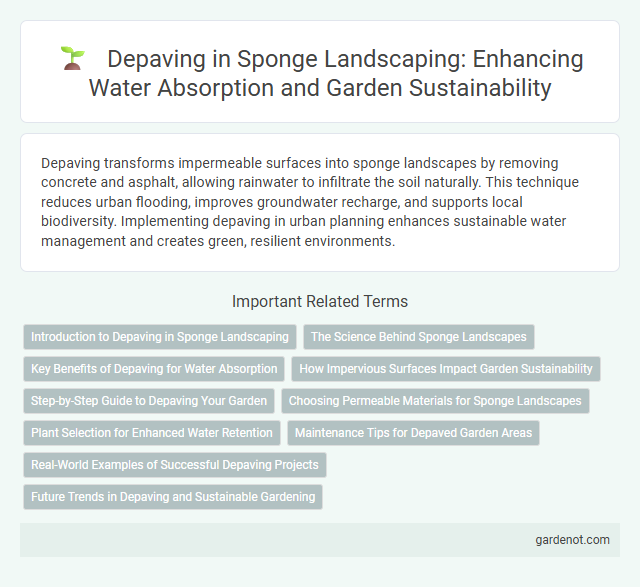Depaving transforms impermeable surfaces into sponge landscapes by removing concrete and asphalt, allowing rainwater to infiltrate the soil naturally. This technique reduces urban flooding, improves groundwater recharge, and supports local biodiversity. Implementing depaving in urban planning enhances sustainable water management and creates green, resilient environments.
Introduction to Depaving in Sponge Landscaping
Depaving in sponge landscaping involves removing impermeable surfaces such as asphalt or concrete to restore natural ground cover, enhancing water infiltration and reducing runoff. This practice improves stormwater management by increasing soil permeability and promoting groundwater recharge through natural absorption. Implementing depaving supports urban flood mitigation, ecosystem restoration, and sustainable water cycle management within green infrastructure.
The Science Behind Sponge Landscapes
Depaving in sponge landscapes enhances urban water absorption by replacing impermeable surfaces with porous materials that mimic natural soil infiltration. Scientific studies demonstrate that removing concrete and asphalt reduces surface runoff, mitigates flooding risks, and promotes groundwater recharge by allowing rainwater to percolate through the soil. This ecological approach supports sustainable stormwater management and improves overall urban resilience against climate change impacts.
Key Benefits of Depaving for Water Absorption
Depaving replaces impervious surfaces with permeable materials, significantly enhancing water absorption and reducing runoff. This process helps recharge groundwater by allowing rainwater to infiltrate the soil, mitigating urban flooding. Increased water filtration through depaved areas also improves soil health and supports local ecosystems.
How Impervious Surfaces Impact Garden Sustainability
Impervious surfaces like concrete and asphalt prevent water infiltration, causing increased runoff that depletes soil moisture crucial for garden health. This runoff often carries pollutants that harm plant growth and disrupt local ecosystems. Depaving transforms these areas into permeable landscapes, enhancing water absorption and improving long-term garden sustainability.
Step-by-Step Guide to Depaving Your Garden
Remove concrete or asphalt surfaces by breaking them into manageable pieces with a sledgehammer, ensuring safety with protective gear. Excavate the underlying compacted material to improve soil permeability, which supports sponge landscape principles like water absorption and runoff reduction. Restore the area with organic soil and native plants to enhance groundwater recharge and foster a sustainable, eco-friendly garden.
Choosing Permeable Materials for Sponge Landscapes
Selecting permeable materials such as porous concrete, permeable pavers, and gravel significantly enhances water infiltration in sponge landscapes, reducing surface runoff and mitigating urban flooding. These materials facilitate natural groundwater recharge and support healthy soil microbiomes by allowing rainwater to seep directly into the ground. Incorporating permeable surfaces in depaving projects optimizes stormwater management while promoting sustainable urban ecosystems.
Plant Selection for Enhanced Water Retention
Choosing native, deep-rooted plants such as switchgrass, sedges, and wildflowers significantly improves water retention in depaving projects by promoting soil permeability and reducing runoff. These plants enhance the sponge landscape's ability to absorb and store rainwater, mitigating urban flooding and supporting groundwater recharge. Incorporating drought-tolerant species further ensures resilience during dry periods, maintaining effective water management year-round.
Maintenance Tips for Depaved Garden Areas
Maintaining depaved garden areas requires regular monitoring of soil health and drainage efficiency to ensure optimal sponge landscape performance. Incorporate organic mulch and compost to enhance soil structure and retain moisture, promoting plant resilience and reducing runoff. Periodic removal of debris and invasive weeds helps maintain permeability and supports the natural filtration of rainwater within the depaved zones.
Real-World Examples of Successful Depaving Projects
Successful depaving projects like Portland's Tanner Creek Plaza have transformed impervious surfaces into thriving green spaces that improve stormwater management and urban biodiversity. In San Francisco, the Pavement to Parks initiative has removed asphalt to create pedestrian-friendly plazas reducing runoff and enhancing community interaction. Seattle's Depave program revitalized schoolyards by replacing parking lots with permeable soil and native plants, significantly reducing urban heat islands and flood risk.
Future Trends in Depaving and Sustainable Gardening
Depaving initiatives are rapidly evolving with increased adoption of permeable surfaces and native plant integration to enhance urban sponge landscapes. Future trends emphasize regenerative gardening practices that reduce runoff, improve soil health, and boost biodiversity in depaved areas. Sustainable gardening techniques combined with advanced water management systems are transforming depaving into a core strategy for resilient urban ecosystems.
Depaving Infographic

 gardenot.com
gardenot.com